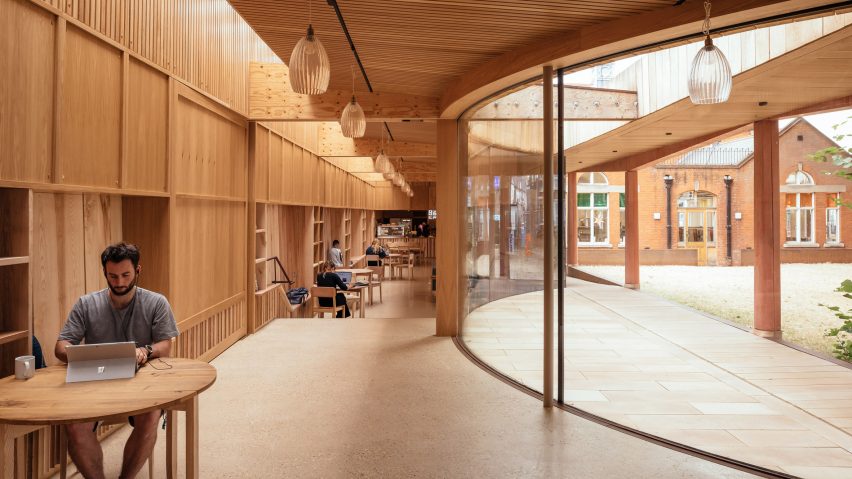Architecture practice Studio Weave has added a wood-lined community centre to Lea Bridge Library in east London, with a red-concrete colonnade that references the original grade II-listed redbrick building.
Built in 1905 in the Edwardian style, Lea Bridge Library in Waltham Forest backs onto a large green space called Friendship Gardens, which the new community wing overlooks through a fully-glazed facade.
Using the existing garden wall as a spine, London practice Studio Weave inserted the narrow, pavilion-like extension along its western edge.
According to the studio, this was an effort to minimise its impact on the original library building and embrace the garden as part of a new "civic heart" for the area.
"We envisaged the extension as a hybridised public space; a new town hall with wider opportunities for citizens to participate more fully in public life," said Studio Weave's director Je Ahn.
"Hybridised public spaces combine and maximise collective resources, and are unexpected engine rooms for community connection," he continued.
While accessible through a refurbished entrance and cafe in the existing library, the community centre's position on the site also allows it to act independently with two entrances created in the garden's eastern and southern edges.
It has a long wood-lined interior, designed to be adapted for a range of uses, ranging from quiet reading rooms to activity spaces for community groups.
Supported by the existing garden wall, the building features beams of laminated veneer lumber (LVL) that cantilever out towards the garden, along with large skylights and a fully-glazed eastern wall that "invites the outdoors in".
Responding to the root systems of the garden's mature trees, the pavilion steps up and features a semicircular cut-out in its centre. Here, a concealed pivoting timber door allows for the space to be subdivided.
Between the glazed facade and the slim concrete colonnade, Studio Weave has inserted a wooden deck and a small paved patio that provide access around the building and offer space for taking in the garden.
Salvaged wood from trees that have been felled across London lines the interior floors, walls and ceilings, providing a variety of colours and textures. This includes fluted timber joinery on the walls in between areas of built-in seating.
Local furniture maker Sebastian Cox also used waste timber to create the Lea Bridge Library centre's furniture, including chairs, tables and sofas that echo the interior finishes.
"Since completing the new library extension, as locals we have witnessed firsthand the impact it has had on the community," said Ahn.
"The extension is always brimming with occupants; children's parties on weekends, students, mother's groups, and workshop attendees each week."
Founded in 2006 by Ahn, Studio Weave is a London studio that works on a diverse range of public and private projects.
Its previous works include the addition of a timber artist's retreat to a home in Devon and an arched greenhouse for the 2020 London Design Festival that drew attention to the UK's rising temperatures.
The photography is by Jim Stephenson.
Project credits:
Architect: Studio Weave
Client: London Borough of Waltham Forest
Structural engineer: Timberwright
M&E consultant: NPS London
Quantity surveyor: NPS London
Landscape consultant: Studio Weave
Furniture and carpentry: Sebastian Cox

